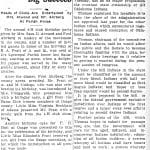Change in Indian Affairs is proposed by Senator Thomas
March 1, 1935
Osage County News
Microfilm Roll: MN00311
Although Indian citizenship was granted by the federal government through the Indian Citizen Act of 1924, after a great deal of Indian participation in World War I, many state governments did not recognize Indians as full citizens until decades later.
This 1935 article discusses Senator Elmer Thomas’ proposal of a bill that would lead to full state citizenship for all American Indians in Oklahoma. In his bill, which was created with the assistance of Representative Will Rogers, Thomas proposes a blood classification system, described as, “Indians with half or more blood would be classified as first degree Indians; and those of less than one-half would be second degree.” Furthermore, the proposed piece of legislation called for the United States government to have, “exclusive jurisdiction over Indians of the first degree and a larger sway over affairs relating to second degree Indians.” Other elements of the proposed bill included government assistance in education, caring for the elderly, and housing, and a request, “to have all tribal claims against the government adjudicated and paid at the earliest possible moment.”
On June 26, 1936 the Thomas-Rogers Bill, also known as the Oklahoma Indian Welfare Act (OIWA), was approved. In its final form, the bill allowed for tribal organization when at least ten members of an already existing tribe wanted to organize. These new tribes were required to, “adopt a constitution and by-laws under certain rules and regulations, and secure a federal charter from the Secretary of the Interior as a local co-operative association” (Wright, 23). Furthermore, Indians who organized under this piece of legislation were allowed the, “right to participate in the revolving credit fund, and other rights, and privileges secured as an organized Indian tribe under the Wheeler-Howard Act,” an act that served as a prior attempt to address the matters of tribal organization (23-5). Many of the American Indian tribes of Oklahoma organized under this piece of legislation, including the Caddo, Kansa, Peoria, and Cheyenne-Arapaho tribes to name a few. The Osages, however, did not organize under the OIWA, but instead were excluded by efforts of lobbyists with interest in Osage oil.
Morgan M. Guzman
“Change in Indian Affairs is proposed by Senator Thomas.”
Osage County News. March 1, 1935, p. 1. Microfilm roll number MN00311. Sequoyah National Research Center, Little Rock, Arkansas.
Further Reading
Clark, Blue.
Indian Tribes of Oklahoma. Norman: University of Oklahoma Press, 2009.
Fletcher, Mathew L.M. “States and their American Indian Citizens.”
American Indian Law Review 41, no. 2 (2017)
. https://digitalcommons.law.ou.edu/cgi/viewcontent.cgi?article=1079&context=ailr (date accessed March 30, 2018).
Wright, Muriel H.
A Guide to the Indian Tribes of Oklahoma. Norman: University of Oklahoma Press, 1986.
Source File(s)
Related Stories
Related Topics
View more stories in
Tags:

